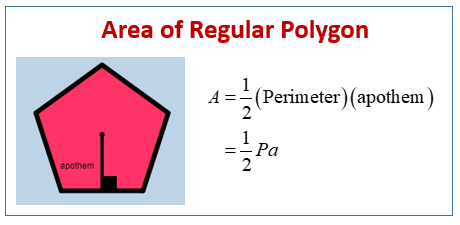Area of Regular Polygons
Videos, worksheets, solutions and activities to help Geometry students learn how to find the area of regular polygons.
The following diagram gives the formula to find the area of a regular polygon using the perimeter and the apothem. Scroll down the page for more examples and solutions.

Area of Regular Polygons
If radii are drawn from the center of a regular polygon to the vertices, congruent isosceles triangles are formed. Using the apothem as the height and the polygon side as the base, the area of each triangle can be calculated and summed. Therefore, the area regular polygons is equal to the number of triangles formed by the radii times their height: (side length)(apothem length)(number of sides)/2.
This lesson gives a detailed view of regular polygons. In addition to identifying terms associated with regular polygons, a few examples regarding area are discussed.
Finding the Area of Regular Polygons
This video shows you how to use a formula to find the area of any regular polygon.
Area of a Polygon - Area of a Hexagon
Students learn the formula for the area of a regular polygon, as well as the definitions of the center, a radius, a central angle, and an apothem of a regular polygon. Students are then asked to solve problems using the formula for the area of a regular polygon.
Try the free Mathway calculator and
problem solver below to practice various math topics. Try the given examples, or type in your own
problem and check your answer with the step-by-step explanations.

We welcome your feedback, comments and questions about this site or page. Please submit your feedback or enquiries via our Feedback page.